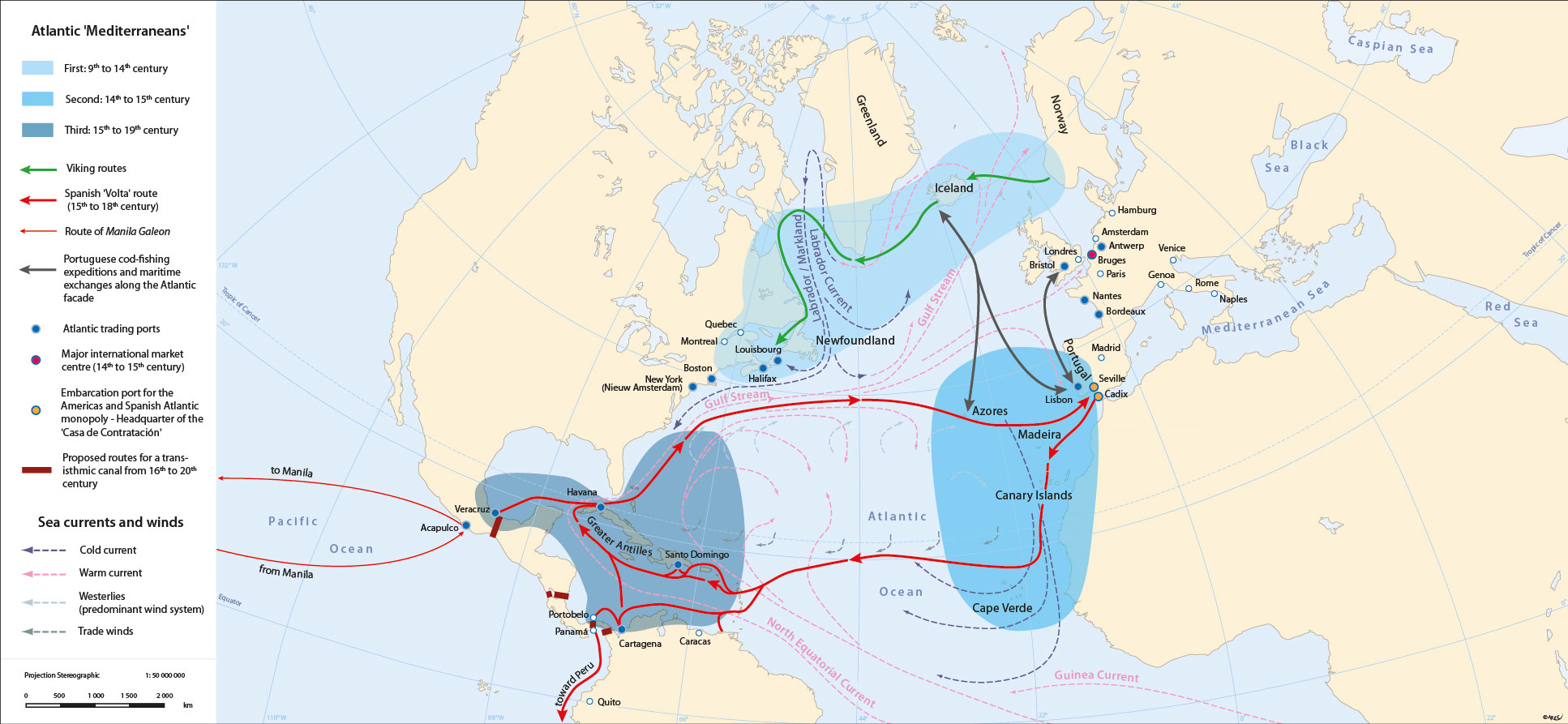
- Atlantic "Mediterraneans"
- Bassin Caraïbe : caractéristiques physiques FR ES
- Caraibe : problématique d'une région FR ES
- Caraïbe, Nord et Sud entremêlés FR ES
- From one resource to another
It was a long accumulation of voyages, experiences, exchanges, commerce, crossings and innovations which brought what the imaginary called Antilla, later to be named the islands of the Caribbean, into the heart of the known world, and the global economies of European powers.
There would be several Mediterranean systems, which successively turned the Atlantic into a finite ocean space in place of a vast unknown. The foundations of this transformation are ancient. A stream of exchanges, dating from Antiquity, had covered the length and breadth of the Atlantic coast from the ‘Pillars of Hercules' in the south to the misty seas of the north: the Phoenicians traded in tin, salt and lead, the Carthaginians in purpura, and the Romans combined trade with the victualling of their legions.
The Atlantic adventure beyond the horizon began in the north; soon after the end of the 9th century, some 30 000 Norwegians settle in Iceland, reaching Greenland around 980. Following the same parallels, hopping from one island to the next, successive voyages brought them regularly to the north of Newfoundland. This represented the first Atlantic Mediterranean.
The second would develop to the south. It was made up of a complex combination of Iberian colonization, the capitalist enterprise of the great Italian merchants, the commercialization of cane sugar and advances in navigation. It favoured the islands of the Atlantic: the Canaries, Azores and Madeira. Here the system of the sugar plantation was developed, originating earlier in Palestine, in the Roman kingdoms of the Orient, migrating to Sicily, then Andalucía, and everywhere dependent on the slave trade to work the plantations. Towards 1300, sugar from Madeira appeared in the markets of Bruges. This was the second of the Atlantic Mediterraneans. For it to exist, it had required a market demand from Europe, high concentrations of populations in the Portuguese Algarve and in Andalucía, bases of settlement not present during the first Atlantic Mediterranean. Also needed was the strong accumulation of Iberian, Italian and German capital to stimulate an extensive system of trading links. Finally, it was dependent too on a number of small new innovations in order to navigate in the zone of the trade winds.
For the third Atlantic, so-called American Mediterranean, it would again require a large accumulation of know how, of both small and major inventions, such as the stern-post rudder and the loose sail which allowed the boat to tack. After the first expeditions of Columbus had shown the way it was then, at the same time as the quest for gold and silver, that the smooth-running system of the second Atlantic Mediterranean could be extended. European markets were constantly seeking increased trade, and the sugar plantation system with its corollary, the slave trade, was self-reproducing. The second Atlantic Mediterranean, which itself had progressively expanded as far as the Cape Verde Islands, would find its counterpart at the other end of the trade winds and their fast navigation sea-passages. The same game of leap frog from one island to the next, in which the seafarers from the north and south of Europe had excelled for centuries, got underway. From being ‘Lands' End,' ‘finisterrae,' the Atlantic ports became locks and gateways, with the routes of the trade winds and ‘westerlies' the means to that wealth destined for the market places of Europe. The third Atlantic Mediterranean opened up new horizons for the Old World.
top
|
  |













